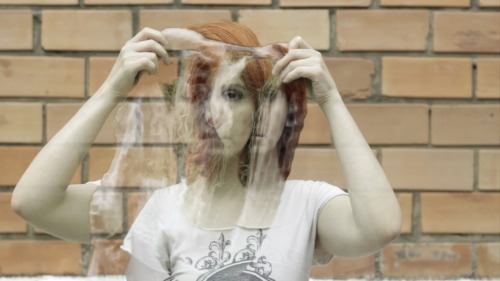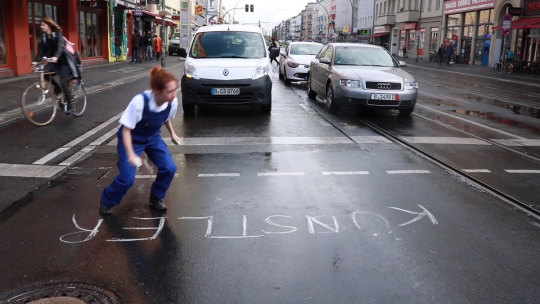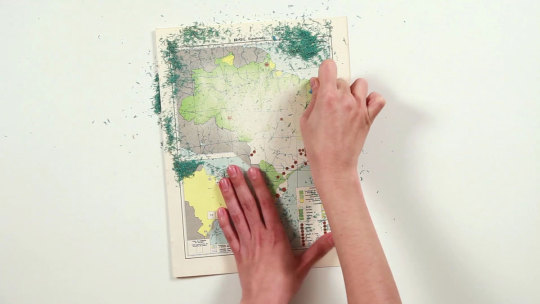
DIRECTORS LOUNGE AT MITTE MEDIA FESTIVAL
IN THE OTHER SIDE, BY HER SIDE
Program I: Friday, April 20, 5:00 pm – 7:00 pm at Z-Bar
Ao lado dela, do lado de lá (In the other side, by her side) curated by Elaine Tedesco is a proposal coming from Brazil, that presents contemporary videos of women artists.
The program shows a whole of interests: the city, urban issues, the arts circuit, performance, social problems, speeches and their forms, feminism, audiovisual language, memory, selfimage, daydreaming, etc. For these artists the video is, each with its poetics, one of the media adopted to create their artwork, but not the only one.
The urban space that seems to be the background to most of the videos presented is much more than that, it is the Vortex of these artists’ productions – here as the spinning movement between the urban experience and the personal imaginary space that creates “other places”. In the routine of large metropolises, public spaces become, increasingly, places of passage, and the borders between public and private gradually become more blurred. It should not be forgotten, however, that these spaces of passage have long since become, in a special way, private spaces, among many others, for the homeless, the street sellers, or the performers.
In the other side, by her side is organized in four interpenetrating axes: videos that are vectors of other works; daily records; videoperformances; and fictions.
complete DL at Mitte Media Festival program here
DL at Mitte Media Festival: In the other side, by her side
Tula Anagnostopoulos – The red carpet, 2017
Rochelle Costi “Negócios à parte”, 2017
Lucia Koch – Yamanaka-san, 2010
Marina Camargo – Brasil, extrativismo (Brazil. Extractivism), 2017
Sandra Becker – Roundtrip , 2017
Marion Velasco – INSTANT BAND, pero esto no es Música. Espanha, 2015/Brasil, 2016
Andressa Cantergiani – Como matar um artista (How to kill one artist), 2017
Viviane Gueller – Camburi (Série Interlúdio) (Interlude series), 2016 Deni Corsino – Faixacorpo, 2017
Lu Rabello – Selfie, 2017
Amanda Teixeira – Changing Rooms, 2017
Dani Amorim – Através (Over), 2017
Natalia Schul – Em pedaços (In slices), 2017
Camila Leichter – Ensaio a pedra (The stone essay), 06 December 2015 – 16 August 2016
Ananda Aliardi – O que tocamos, o que nos toca (What we touch, what touches us), 2017
Daniela Távora and Itapa Rodrigues – Quem vai ser o rato do século XXI (Who will be the mouse of the 21st century), 2017
Ana Paula Pollock – Crise (Crisis), 2017
Samy Sfoggia – Aféfé Ikú, 2017
About the videos:
AMANDA TEIXEIRA Changing Rooms, 4’45" (2017)
Looking for a place to live in Munich I wrote for more than 100 landlords, I received eight answers, and I visited 3 apartments. How can a house become a home?

ANDRESSA CANTERGIANI
Como matar um artista (How to kill one artist), 8′ (2017)
From the questions how to kill one artist, how to kill the public and how to kill the work, I perform one action in the middle of the traffic in Porto Alegre, Brazil and Berlin. The video intent a urban analogy about the differences and connections involving the two cities and the artist attitude in relation to authorship and participation in the art system.
ANA PAULA CUNHA
CRISE (CRISIS), 3’13" (2017)
Living a crisis and experiencing a pulsion that creates new signs from a encounter. Crisis is the chaos of the becoming-world: it paints pink upon pink in order to become itself imperceptible in constant contemporary vigilance.
ANANDA ALIARDI
O que tocamos, o que nos toca (What we touch, what touches us), 3’57″ (2017)
Ineluctable, but it is the split that separates within us what we feel from what touches us: insult is also impulse. The video brings reproductions and reactions to what women instrumentalists hear from men about their competences.

CAMILA LEICHTER
Ensaio a pedra (The stone essay), 8’17″ (06 December 2015 – 16 August 2016)
Synopsis: I found in Samuel Beckett’s Molloy (1947) one language proposition about a image thought to be transformed into action: before the unspeakable of experience, suck the same four stones in succession.
DANI AMORIM
Através (Over), 4’7″ (2017)
Over it is a reflection about the self-identity and how we offer ourselves be seen by the other. A visual metaphor of resisting and allowing look through our surface, into the real self, without shields.
DANIELA TÁVORA and ITAPA RODRIGUES
Quem vai ser o rato do século XXI (Who will be the mouse of the 21st century), 2’53″ (2017)
“A white horse, without ensiles and without reins, graze in the middle of a road, whoever who rides the animal will be taken to a garden of paradise, and when he comes down, his feet will be crossed by thorns hidden in the grass”; The record was held at Vila Cruzeiro in Porto Alegre, Brazil, a neighborhood that has become a endless construction site, since the city hall began to open a new avenue where the houses of the first residents remained.
DENI CORSINO
Faixacorpo, 1’45″ (2017)
Faixacorpo associetes urban space issues and the performance attitude in order to raise a critical view about the contemporary city, full of buildings and big avenues that doesn’t have restores spaces for the citzens. Moving with my own security strip, I can choose my path, to stay, to live, to be present and to occupy the urban space.
LU RABELLO
Selfie, 3’19 ‘’ (2017)
Selfie in cross point and comments about the work.
LUCIA KOCH
Yamanaka-san, 5’45″ (2010)
Synopsis: In a kimonos fabric store, a saleswoman displays some fabrics, demonstrating their qualities, their weight, trim, color and luster, volumes and folds. But in these fabrics there are no figures of birds or flowers, no pattern printed. They seems too simple, except for the colors bending over each other. The continuous gradient transition “breaks” as the saleswoman moves the fabrics. She also seems to be exploring this material, trying to discover her possibilities to sensitize the customer. The video was made for the Wave project (Choja Machi, Aichi Trienale, 2010, Nagoya, Japan).

MARINA CAMARGO
Brasil, extrativismo (Brazil. Extractivism), 10’14" (2017)
The action of erase a Brazil school map is recorded on video. The title of the map gives the name to the work, while, at the same time, along with the gesture of erasing these regions of the map it refers to one important ecological issue related to the current public policies of the country.

MARION VELASCO
INSTANT BAND, pero esto no es Música. Espanha, 2015/Brasil, 9´36″, 2016.
Performance by Marion Velasco (BRA) in collaboration with Seth Rossano (MEX) on bass and Carlos Llavata (ESP) on clarinet. Images by Marion Velasco and Verónica Hernández Menchara (MEX), sound capture by Miguel Molina Alarcón (ESP).
INSTANT BAND deals with the snapshot, the immediate, the transient, the passing. The format refers to the street music, to the instant bands that, in general, are configured and present themselves in the urban space for an audience, also, dynamic. Throwing glass bottles at the collector for recycling is a noisy and everyday action on the streets of Spanish cities, but by mixing it live, with an amplified electric bass and a clarinet, the action has become a sound performance and a transgression. INSTANT BAND, but this is not Music is a sound performance, collaborative, remote and therefore oriented to audio and video
NATALIA SCHUL
Em pedaços (In slices), 2’48" (2017)
She moves broken mirrors that show fragments of her face and the front of her body to the fixed camera that only captures the back and the vision provided by the mirror’s reflexes.
ROCHELLE COSTI
“Negócios à parte” , 10’03" (2017)
The video “Negócios à parte” was held for the recent exhibition Avenida Paulista no Masp, São Paulo. In a survey of about 8 months, the artist traveled the avenue dozens of times, recording invisibility through characters detached from the corporatist profile of the region and small incidental and ephemeral events. Renato Firmino, painter, scavenger and resident of the avenue participate as a conductor of the video and make a partnership with
the artist. In the exhibition, his car serves as space for the projection of the video. Soundtrack: Sara Não Tem Nome.
SAMY SFOGGIA
Aféfé Ikú, 01′38″, p&b (2017)
Video Art pos Dadaist, tupi or not tupi.
SANDRA BECKER
Roundtrip, 2’53″ (2017)
The Video is a search of life. Where do we go to and what are we looking for?It is shot in New York and in Berlin using both cities as reference in the art world where artists are searching their way to got to. The elevator is used to show the up and downs artists are facing trying to finance their projects.
TULA ANAGNOSTOPOULOS
The red carpet, 2" (2017)
The video “The Red Carpet"; problematizes the relationship between audience and artist during a walk through the red carpet. During a walk through the red carpet, the red carpet stretched out to the ground indicates a way forward. It is a remarkable path to walk, with slow or rapid steps, to walk under the eyes of a public desirous to see the stars – mainly actors and actresses. (When you are part of the convenient group of anonymous people who for one reason or another are out of focus, the trajectory is a moment of suspension: neither reality nor illusion.) Look at all sides at once: when you are inside and /
or when you’re out? This video was made in collaboration with Tecna PUC / RS, Kolor360º during the 45th Gramado Film Festival, Brazil.
VIVIANE GUELLER
Camburi (Série Interlúdio) (Interlude series), 01’54″ (2016)
The Interlude series is constitutes from situations of suspension in daily life. In a interference of the sound over the image, the Camburi video traces the experience from the displacement and the waiting as poetic exercise.
